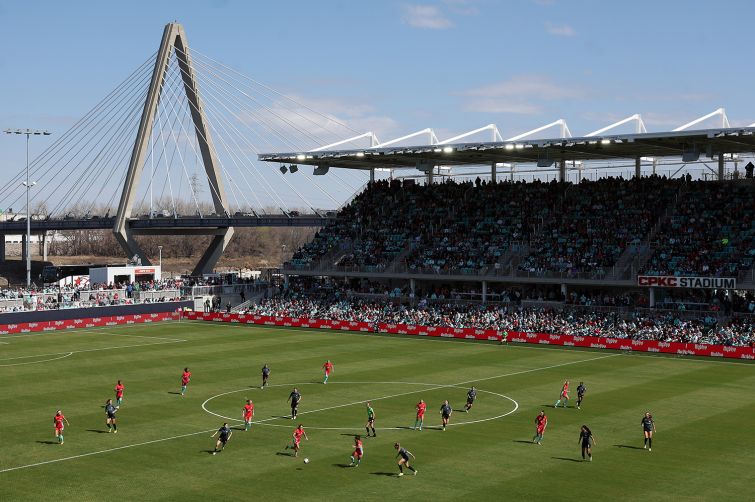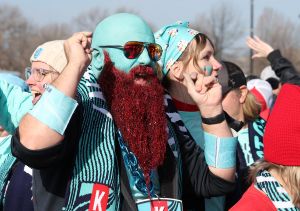NWSL Season Kicks Off at First-Ever Professional Women’s Stadium
The CPKC Stadium opening showcases the growing investment in women's sports, and could herald even more of it
By Chava Gourarie March 15, 2024 4:29 pm
reprints
Women’s sports is in winning form these days.
Investment in women’s sports broke $1 billion for the first time in 2023, while attendance and viewership broke records across every sport. National Women’s Soccer League (NWSL) viewership was up 400 percent and attendance up 32 percent; the WNBA had its most watched season in 21 years; a record 92,003 fans showed up for a college volleyball game in Nebraska, and stars like Iowa basketball standout Caitlin Clark drew unprecedented crowds and hype.
And, this weekend, women’s sports will reach another major milestone. The Kansas City Current will play the opening game of the NWSL season in the brand-new CPKC Stadium in downtown Kansas City, Mo., the very first stadium purpose-built for a professional women’s team.
“There are now ownership groups in women’s sports that are taking the sports seriously, and they’re taking profit maximization seriously,” said Nola Agha, a University of San Francisco professor who specializes in sports economics and finance. “It means treating the women’s sport as if it’s the same as any other for-profit business. And that’s a change in mindset.”
The KC Current was founded in 2020 by power couple Angie and Chris Long, along with Brittany Mahomes, wife of Kansas City Chiefs quarterback Patrick Mahomes, who joined the ownership group last year. The co-owners announced plans for the stadium back in 2021 and broke ground in 2022 on the $117 million arena, which is along the Berkley riverfront in an area undergoing substantial redevelopment.
The arena is off to quite the start. The 11,500-seat arena is already sold out for every home game of the season, which marks a 46 percent increase above the average attendance for an NWSL game. And amid last year’s rush of WNBA media deals and record-breaking events, KC Current ownership closed on a 10-year naming rights deal for the stadium with Canadian railway giant CPKC in October, adding an additional revenue stream for the team. Earlier this week, the team announced it would host college’s Big 12 Conference soccer tournament in 2024 and 2025, another source of revenue.
Which is, of course, what the stadium was made for.
“It’s very symbolic, but it’s also very economical,” Victor Matheson, a professor of economics at College of the Holy Cross, said of the stadium. “If you’re a tenant in someone else’s stadium, that means lots of things are lost to you as revenue streams.”
Until now, all women’s professional teams in the U.S. have rented space where they could, including in arenas used primarily for men’s sports as well as in college or youth facilities, or they’ve shared space with other teams. As they are usually the secondary or even tertiary tenant, women’s teams lose out on revenue from concessions, jersey sales, suite rentals and sponsorships, which are controlled by the stadium owner or primary tenant.
“In the context of professional sports, you don’t necessarily have to own your own arenas, but you do have to have control of all your sources of revenue,” said Agha. “Owning the stadium is a great testament to the ownership group, but the most important part is the team now controls and owns all the revenue streams.”
In the case of the NWSL, some teams share a stadium with MLS teams in a dedicated soccer stadium. In fact, the two teams drawing the biggest crowds in 2023 — Angel City FC in Los Angeles and the Portland Thorns FC — follow this model, playing in BMO Stadium and Providence Park, respectively. Until this year, KC Current played in Children’s Mercy Park, a stadium built for Sporting KC, the city’s MLS team.
The same goes for the WNBA, and other professional women’s leagues as well as across the pond, and all across Europe. Despite the prominence of European soccer clubs, women’s leagues that share the same names as England’s biggest clubs play in smaller facilities, in youth academies, or on college grounds, primarily because they don’t draw the same crowds as the men’s teams.
That’s a byproduct of the longstanding underinvestment in women’s sports.
“Historically, women’s sports have been an afterthought,” said Agha. “They’ve certainly been an afterthought in professional settings. The early owners did it out of sympathy.”
England offers a potent lesson in the consequences of sidelining women’s sports. The British banned women from playing in any Football Association stadium for over 50 years, after women’s soccer exploded in popularity during World War I while the men were at war and the men’s game was suspended.
The ban went into effect in 1920, just after a women’s league final drew a record crowd of 53,000 fans. Opponents of this phenomenon helped spread panic about the game’s effect on women — physically and morally — with the help of questionable medical professionals. The ban was not lifted until the 1970s, effectively smothering women’s soccer in England for decades. The game became more professional during the 1990s, when the current women’s league system was instituted.
Now, the English women’s team outshines the men’s team on the international stage. “England, which takes pride in inventing the game — their men’s team has sucked,” said Matheson. “They have a grand total of one title, when they played it at home in 1966.”
But the English women’s team won the Euro Cup in 2022, reached the World Cup final in 2023, and sold out Wembley Stadium when they played against the U.S. last May. Similarly, the U.S. Women’s National Team has won four World Cups. The men — well, it’s a win if they qualify.
As attitudes change toward women’s sports, the virtuous cycle of investment and attention continues to escalate, with bigger crowds, more lucrative media deals, and higher valuations. More importantly from an investment perspective, the benefit in women’s sports is that it still has plenty of room to grow.

“What we’re seeing now is a market that’s not been tapped,” said Robyn Lubisco, an associate professor of sports management at Fairleigh Dickinson University. “Right now, NWSL is a good product and they make money.”
While the majority of sports investments areis tied to media deals, other revenue streams matter just as much. The KC Current stadium therefore makes a statement about the professionalization of the women’s game, and could also entice other teams to follow suit.
“The hope is that once this stadium takes off and it does well it will translate to other sports,” said David Caputo, an analyst at Moody’s Analytics who authored a report on the growth of women’s sports facilities. “If it’s helping these teams become more successful, and they’ll get higher attendance at the games, it will spread out to other teams who will want to get in on the action.”
That’s already the case in Boston, where the owners of an upcoming NWSL franchise are planning a $30 million redevelopment of Boston’s existing White Stadium, part of a larger development plan with the city. The deal is backed by Boston Unity Soccer Partners, the group that owns the as-yet-unnamed expansion team, which will begin to play in 2026 alongside new NWSL teams in San Francisco and Salt Lake City.
“With respect to the Boston issue, I would say that the success of the new expansion teams in L.A., San Diego, as well as the stadium being built in Kansas City, is exactly the sort of thing that spurred a new Boston ownership group to come back into this market,” said Matheson.
Not only that, but it would have led to their decision to invest in a stadium of their own to control their own revenues. “They had been playing at Harvard Stadium, but that makes money for Harvard, not for the team,” Matheson added.
That said, it’s unlikely that it will spark a huge wave of stadium construction, because many NWSL teams are already settled in contracts to share MLS stadiums, while other sports arenas are harder to build.
Plus, it remains to be seen how soon KC Current revenue will offset the cost of building the CPKC Stadium. “There’s no doubt this will have a positive effect on revenues. Whether it’s positive enough to pay for the outlays that the owners have put out on this, that’s a whole other question,” said Matheson.
That said, this could just be the start. KC Current intends to follow a similar playbook to other sports teams that rely on mixed-use development around the stadium for further sources of revenue.
“The way stadiums are getting built now, it’s with the intention of having the game experience last longer than the game itself,” said Caputo. “That’s why it’s switching now to being more urban, to having tons of other options.”
Last July, the team secured an additional 11 acres of publicly owned land along the waterfront near the stadium, as well as the rights to develop an $800 million mixed-use neighborhood, with more than 1,000 apartments in several towers, as well as office and retail space, to be completed over the next 10 years. The deal has the backing of Port KC, the governmental development authority which controls the site, and includes a 15-year property tax abatement as well as other incentives.
So not only will other teams be watching closely to see how the arena impacts the finances, but local governments and developers may also be looking at the impact of the stadium on the surrounding area. “This is a test case,” said Caputo. “If this is a real success, other governments might see how this is working and they’ll want to finance stadiums in the future, like they do for men’s teams.”
For now, the important thing is winning. As the NWSL season kicks off Saturday, many players will be fresh off the U.S. Women’s National Team victory in the first-ever CONCACAF Women’s Gold Cup, where the team took home gold after a 1-0 win against Brazil last week.
And they’re just getting started.
But it’s the strategic investment that makes it possible.
“It took a group of owners to take the sport seriously, and not treat it as a subcategory, in order for this moment to occur,” said Agha. “It’s the full compilation of taking it seriously, staffing it properly and running it as a professional business.”
Chava Gourarie can be reached at cgourarie@commercialobserver.com.


